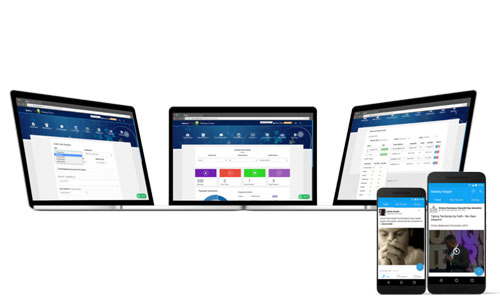Web apps can sometimes get lost in all the talk of mobile apps and websites, but there’s no denying how useful they can be. What is a web app? It’s essentially an application that’s built on the web to serve a specific purpose. It’s different from a website in that it’s often an extension of your website. People can visit your site, then load up an app on a separate page. Web apps have specific functions, which is the whole reason they’re created. Whereas, a website is just a set of web pages.
So, why should your business build a web app – and how should you go about doing it? If you get yourself nice and relaxed, you can get ready to find the answers to both these questions down below:
Why Your Business Needs A Web App
Many business owners have considered developing a web app, while others have probably never even thought about it. Regardless of anything you may have been told before, you need to understand that there are benefits to having a web application. Here are some of the key ones:
Increased Automation
Automation refers to when processes are done automatically instead of taking lots of time. With a web app, you can build something that’s designed to increase automation in your business. An excellent example of this is an online application that your employees sign into to receive their workload for the day. Tasks are assigned automatically, and it moves things along nicely.
Improve Your Website
There are loads of different web apps out there, and one idea is to have one built into your website for consumers to use. This can come in the form of an e-commerce application, or perhaps something like a platform for them to create an account and manage their orders. Having a web application will help enhance and improve your website in so many ways. For one, the functionality should be increased. Secondly, it can make your site look more visually appealing and impressive, improving people’s impression of your business.
Provide Solutions To Existing Problems
A lot of businesses choose to build a web app because it helps them solve a problem they might have. The example of a work management application is handy to look at here again. You may need this web app because it solves the problem of work being assigned poorly and not on time, or employees failing to get clear instructions, etc. If you’ve got a platform where everything is kept in the same place, it helps solve any issues. The same can be said for any other aspects of your business that can be improved with a web app.
All in all, web applications are a neat addition to your business. I always feel that it makes a company look more respectable and professional too. I mentioned this when talking about the way it improves your site, but it can certainly give you a professional edge that you may have been lacking beforehand.
How To Build A Web App For Business
Right, you’ve seen some of the reasons you should build a web app, but how do you go about putting your plans into action? It can be a tricky process, and it may take time for it to be perfected. So, before I go into detail, I’ll say this; don’t set a date for your app to be finished. It’s highly unlikely it will be ready by then as there’s no way to predict how long it takes to build a web app. It depends on how smoothly the whole process goes!
Speaking of which, here’s some advice on how to go about developing your first web app:
Hire A Development Team
Unless you happen to be a software development expert, then the chances are you need a team to help you out. There are some places online where you can get web apps designed quickly, but if you want to go down the custom route, then a team is needed. Here, you can outsource, but it’s preferable to have at least someone in-house to communicate with. This will make it easier down the line.
Come Up With A Project Brief
Naturally, you should think of a project brief to give to your development team. This will detail everything you want from the app. Be sure to come up with the principal purpose of your application, and the features you want to see in it. If possible, try and think about some design ideas, though they will likely mock up a few sketches to show you and get your opinions on. The brief gives your team something to work towards and ensures they’re on the same page as you.
Test The App
Hopefully, your team will go away and start making the first installment of the app for you. When they reach a point where it’s somewhat usable, they let you try it out. This is known as an alpha test, as it’s the first version of the app that’s ever been used. You should get a feel for it, and see if you like the way it looks/works.
Provide Feedback
At this stage, you should make notes about everything you like and dislike about the Alpha version of your app. Then, you should provide feedback. If you don’t know how to give feedback to your development team, then it’s basically a case of providing the positive points alongside constructive criticism. Don’t just say you hate this and that, tell them why you dislike these things and what you maybe want them to improve. This gives them something to work on as they continue the development.
Test Again
Now, we have the Beta test, which comes after you’ve given your feedback and the team has had time to iron out the creases. This should be close to the finished product, but there may be a few kinks here and there that need improving. Test it yourself, but also get your team to try out the app as well. Here, the testing phases can be a bit longer – anywhere from a few days to a couple of weeks is good. It gives you an idea of how user-friendly the app is while seeing how other people respond to it. Then, collect everyone’s feedback and pass it on to the development team so they can finally iron out the final creases.
Launch The App
After this, you should be in a position where the app is fully-tested and gets your seal of approval. Now, you can launch it on your website, and get ready for a new era. Please be aware, there will probably still be some minor issues that crop up as your app continues to be used. If you spot anything, notify your development team so they can try and fix them as soon as possible.
It might seem simple when it’s laid out like this, but it can take a long time for everything to be finalized and produced. Some web apps have a nice smooth ride where the development team almost nail it right away. Other times, a sophisticated app can have way more issues and require more rigorous testing.
Either way, you now know how to go about developing your very own business web app. If you were paying attention earlier, then you’ll also see why it can be beneficial. Could this be an idea that helps catapult your business in the direction of success? Well, it’s certainly something to start thinking about.



